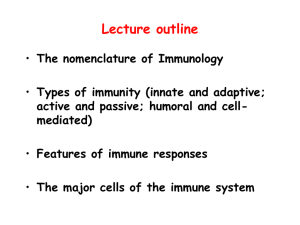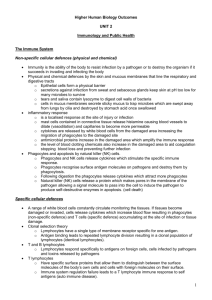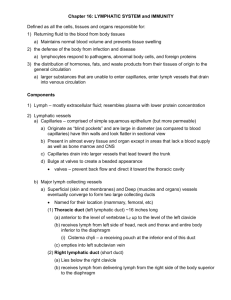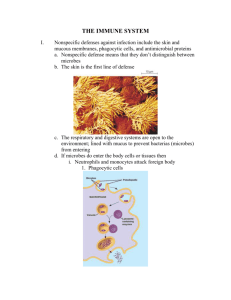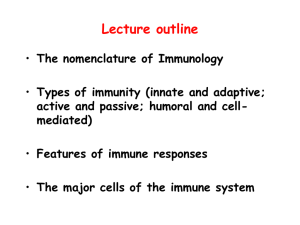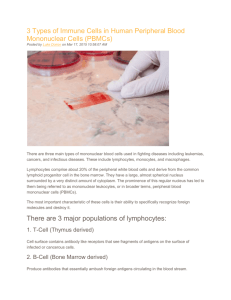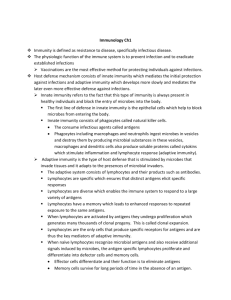Chapter 1 - Abbas
advertisement
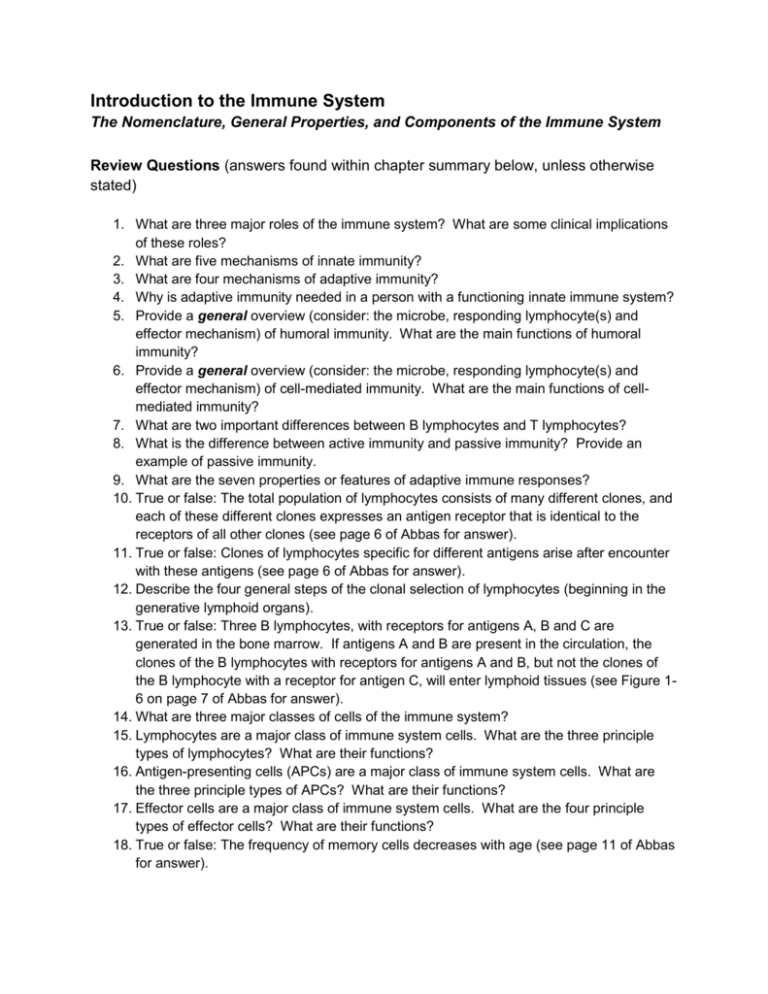
Introduction to the Immune System The Nomenclature, General Properties, and Components of the Immune System Review Questions (answers found within chapter summary below, unless otherwise stated) 1. What are three major roles of the immune system? What are some clinical implications of these roles? 2. What are five mechanisms of innate immunity? 3. What are four mechanisms of adaptive immunity? 4. Why is adaptive immunity needed in a person with a functioning innate immune system? 5. Provide a general overview (consider: the microbe, responding lymphocyte(s) and effector mechanism) of humoral immunity. What are the main functions of humoral immunity? 6. Provide a general overview (consider: the microbe, responding lymphocyte(s) and effector mechanism) of cell-mediated immunity. What are the main functions of cellmediated immunity? 7. What are two important differences between B lymphocytes and T lymphocytes? 8. What is the difference between active immunity and passive immunity? Provide an example of passive immunity. 9. What are the seven properties or features of adaptive immune responses? 10. True or false: The total population of lymphocytes consists of many different clones, and each of these different clones expresses an antigen receptor that is identical to the receptors of all other clones (see page 6 of Abbas for answer). 11. True or false: Clones of lymphocytes specific for different antigens arise after encounter with these antigens (see page 6 of Abbas for answer). 12. Describe the four general steps of the clonal selection of lymphocytes (beginning in the generative lymphoid organs). 13. True or false: Three B lymphocytes, with receptors for antigens A, B and C are generated in the bone marrow. If antigens A and B are present in the circulation, the clones of the B lymphocytes with receptors for antigens A and B, but not the clones of the B lymphocyte with a receptor for antigen C, will enter lymphoid tissues (see Figure 16 on page 7 of Abbas for answer). 14. What are three major classes of cells of the immune system? 15. Lymphocytes are a major class of immune system cells. What are the three principle types of lymphocytes? What are their functions? 16. Antigen-presenting cells (APCs) are a major class of immune system cells. What are the three principle types of APCs? What are their functions? 17. Effector cells are a major class of immune system cells. What are the four principle types of effector cells? What are their functions? 18. True or false: The frequency of memory cells decreases with age (see page 11 of Abbas for answer). 19. Which of the following is not considered a peripheral lymphoid organ (see page 11 of Abbas for answer)? a. Lymph nodes b. Thymus c. Spleen d. Mucosal lymphoid tissue e. Cutaneous lymphoid tissue 20. True or false: Memory cells are considered to have effector function (see Figure 1-11 on page 12 of Abbas for answer). 21. True or false: The lifespan of effector cells is usually quite prolonged (see Figure 1-11 on page 12 of Abbas for answer). 22. True or false: The immunoglobin (Ig) receptors on naive cells have low affinity for antigen (see Figure 1-11 on page 12 of Abbas for answer). 23. True or false: Class-switching is a property of memory B cells (see Figure 1-11 on page 12 of Abbas for answer). 24. True or false: Naive T cells migrate to lymph nodes (see Figure 1-11 on page 12 of Abbas for answer). 25. What is the defining feature of the “professional antigen-presenting cell”? 26. True or false: Within the peripheral lymphoid organs, T lymphocytes and B lymphocytes are segregated into different anatomic compartments. 27. True or false: The periarteriolar lymphoid sheath (PALS) and lymphoid follicles together constitute the white pulp of the spleen (see Figure 1-13 on page 15 of Abbas). 28. Where are B cells concentrated in the lymph node? Where are T cells concentrated in the lymph node? 29. Where are B cells concentrated in the spleen? Where are T cells concentrated in the spleen? 30. Why are naive B cells concentrated in the follicles of lymph nodes and the spleen? Why are T cells concentrated in the paracortex of lymph nodes and the PALS of the spleen (see page 15 of Abbas for answer)? 31. True or false: Altered chemokine receptor expression within activated lymphocytes leads to the migration of B and T cells towards one another and they ultimately meet up within the germinal centres of lymph node and splenic follicles. 32. True or false: Effector B lymphocytes must migrate to sites of infection because their production of antibodies are critical to the elimination of microbes at the sites of infection. 33. True or false: The activating encounter between an antigen and a T lymphocyte in the T cell zone of lymph nodes is a random event. 34. True or false: Concentration gradients of phospholipids pull activated T cells out of the lymph node and into the blood stream. 35. How does the immune system ensure the adaptive immune response is induced by microbes and not by harmless substances? Terminology Active immunity: immunity induced in an individual by infection or vaccination Adaptive immunity: develops more slowly and mediates the later, even more effective, defense against infections; is the type of host defense that is stimulated by microbes that invade tissues (in other words, it adapts to the presence of microbial invaders) Antibodies: produced by B lymphocytes; are secreted into the circulation and mucosal fluids, and they neutralize and eliminate microbes and microbial toxins that are present outside of host cells, in the blood and in the lumens of mucosal organs Antigens: substances specifically recognized by the adaptive immune system; includes substances produced by microbes and non-infectious molecules Cell-mediated immunity: involves defense against intracellular microbes and is mediated by T lymphocytes Cytokines: soluble proteins which stimulate inflammation and lymphocyte responses Cytotoxic T lymphocytes: kill cells (via lysis) harbouring intracellular microbes Dendritic cells: type of APC; the long processes of dendritic cells capture protein antigens of microbes that enter through the epithelia and transport the antigens to regional lymph nodes Effector cells: are the differentiated progeny of naive cells that have the ability to produce molecules that function to eliminate antigens Helper T cells: CD4+ cells that help B lymphocytes to produce antibodies and help phagocytes to destroy ingested microbes High endothelial venules: the site where naive T cells (and possibly naive B cells) enter lymph nodes; the endothelial cells of HEVs express carbohydrate ligands on their surface, which recruits the L-selectin receptor on the surface of naive T cells Humoral immunity: mediated by proteins called antibodies, which are produced by cells called B lymphocytes Immune response: the coordinated reactions of the immune system to infectious microbes Immune system: the collection of cells, tissues, and molecules that mediate resistance to infection Immunity: resistance to disease, specifically infectious disease Innate immunity: mediates the initial protection against infections; is always present in healthy individuals and prepared to block the entry of microbes and to rapidly eliminate microbes that do succeed in entering host tissues Lymph node follicles: B cells are concentrated in these regions, which are located around the periphery or cortex, of each lymph node Lymph node germinal centres: a central region within the follicle that may be present if B cells in the follicle have recently responded to an antigen Lymph nodes: nodular aggregates of lymphoid tissues located along lymphatic channels throughout the body Memory lymphocytes: long-lived cells that are induced during a primary immune response Naive individual: someone who has not been exposed to a particular microbial antigen Naive lymphocytes: express receptors for antigens, but do not perform the functions that are required to eliminate antigens Natural killer cells: kill infected cells, but they do not express the kinds of clonally distributed antigen receptors that B cells and T cells do; components of innate immunity capable of rapidly attacking infected cells Passive immunity: immunity conferred on an individual by transfer of antibodies or lymphocytes from an actively immunized individual (i.e., protection of newborns from infection by acquiring antibodies from their mothers through the placenta and in milk) Plasma cells: antibody-secreting cells that are considered effector cells in the B lymphocyte lineage Primary immune response: the response to the first exposure to an antigen; mediated by naive lymphocytes that are seeing the antigen for the first time Primary lymphoid organs: T and B lymphocytes mature and become competent to respond to antigens Regulatory T lymphocytes: CD4+ cells that function to prevent or limit immune responses Secondary immune response: the response to an antigen for which exposure has previously occurred; the response is mediated by memory lymphocytes and is usually more rapid, larger, and better able to eliminate the antigen than a primary response Secondary lymphoid organs: adaptive immune responses to microbes are initiated Spleen: an abdominal organ that plays a role in the immune response to blood-borne antigens Condensed Version of Chapter 1 Introduction The physiologic function of the immune system is to prevent infections and to eradicate established infections. The major roles of the immune system include: 1. Defense against infections 2. Recognition and response to tissue grafts and newly introduced proteins 3. Defense against tumours Clinical implications of these roles include: 1. 2. 3. 4. Deficient immunity results in increased susceptibility to infection (exemplified by AIDS) Vaccination boosts immune defenses and protects against infections Immune responses are barriers to transplantation and gene therapy Potential for immunotherapy of cancer Innate and Adaptive Immunity Mechanisms of innate immunity include: 1. 2. 3. 4. 5. Epithelial barriers (and the specialized cells and natural antibiotics present in epithelia) Phagocytes Dendritic cells Natural killer cells Complement (and other plasma proteins) These agents of innate immunity recognize and react against microbes, but do not react against non-infectious foreign substances. Different components of innate immunity may be specific for molecules produced by different classes of microbes. In addition to providing early defense against infections, innate immune responses enhance adaptive immune response against the infectious agents. Mechanisms of adaptive immunity include: 1. 2. 3. 4. B lymphocytes Antibodies (eliminate microbes in extracellular fluids) T lymphocytes (eliminate microbes living inside cells) Effector T cells Many microbes that are pathogenic for humans have evolved to resist innate immunity. Whereas the mechanisms of innate immunity recognize structures shared by classes of microbes, the cells of adaptive immunity, namely, lymphocytes, express receptors that specifically recognize different substances produced by microbes as well as non-infectious molecules. These substances are called antigens. Adaptive immune responses are triggered only if microbes or their antigens pass through epithelial barriers and are delivered to lymphoid organs where they can be recognized by lymphocytes. Adaptive immune responses often use the cells and molecules of the innate immune system to eliminate microbes, and adaptive immunity functions to greatly enhance these antimicrobial mechanisms of innate immunity. Types of Adaptive Immunity General overview and main functions of humoral immunity: 1. Extracellular microbes present 2. B lymphocytes respond by secreting antibodies Main functions: block infections and eliminate extracellular microbes General overview and main functions of cell-mediated immunity: 1. Phagocytosed microbes present in macrophage 2. Helper T lymphocytes respond by binding to macrophage Main functions: activate macrophages to kill phagocytosed microbes AND 1. Intracellular microbes (i.e., viruses) replicated within cell 2. Cytotoxic T lymphocytes respond by binding to the infected cell Main functions: kill infected cells and eliminate reservoirs of infection Important differences between B lymphocytes and T lymphocytes: 1. B lymphocytes recognize extracellular microbial antigens (via antibodies) whereas T lymphocytes recognize antigens produced by intracellular microbes 2. B lymphocytes (via antibodies) are able to recognize many different types of molecules, including proteins, carbohydrates, and lipids, whereas most T cells recognize only protein antigens Properties of Adaptive Immunity Properties of adaptive immune responses include: 1. 2. 3. 4. Specificity: ensures that distinct antigens elicit specific responses Diversity: enables immune system to respond to a large variety of antigens Memory: leads to enhanced responses to repeated exposures to the same antigens Clonal expansion: increases number of antigen-specific lymphocytes to keep pace with microbes 5. Specialization: generates responses that are optimal for defense against different types of microbes 6. Contraction and homeostasis: allows immune system to respond to newly encountered antigens 7. Nonreactivity to self: prevents injury to the host during responses to foreign antigens The process of clonal selection: 1. 2. 3. 4. Lymphocyte clones with diverse receptors arise in generative lymphoid organs Clones of mature lymphocytes specific for many antigens enter lymphoid tissues Antigen-specific clones are activated (“selected”) by antigens Antigen-specific immune responses occur Cells of the Immune System Lymphocytes are the only cells that produce specific receptors for antigens and are thus the key mediators of adaptive immunity. The major types of lymphocytes and their principle functions include: 1. B lymphocytes – mediators of humoral immunity capable of specific recognition of antigens (via membrane forms of antibodies); mature in the bone marrow; only cells capable of producing antibodies; effector functions include: a. Neutralization of microbe b. Phagocytosis c. Complement activation 2. Helper T lymphocytes (CD4+ cells) – mediators of cell-mediated immunity capable of specific recognition of antigens (via receptors that recognize peptide fragments of protein antigens that are bound to specialized display molecules called histocompatibility complex (MHC) on the surface of APCs); mature in the thymus; effector functions include: a. Activation of macrophages b. Inflammation c. Activation (proliferation and differentiation) of T and B lymphocytes (help B cells produce antibodies) Note: a special class of CD4+ cells called regulatory T lymphocytes function to prevent or limit immune responses. 3. Cytotoxic T lymphocytes (CTLs) – mediators of cell-mediated immunity capable of specific recognition of antigens (via receptors that recognize peptide fragments of protein antigens that are bound to specialized display molecules called histocompatibility complex (MHC) on the surface of APCs); mature in the thymus; effector function include: a. Killing of infected cell (via lysis) 4. Natural killer (NK) cells – cells of innate immunity that do not express the kinds of clonally distributed antigen receptors that B cells and T cells do; effector function: a. Killing of infected cell When naive lymphocytes recognize microbial antigens and also receive additional signals induced by microbes, the antigen-specific lymphocytes proliferate and differentiate into effector cells and memory cells. Naive lymphocytes express receptors for antigens, but do not perform the functions that are required to eliminate antigens. These cells reside in and circulate between peripheral lymphoid organs and survive for several weeks or months, waiting to find and respond to antigen. If they are not activated by antigen, naive lymphocytes die by apoptosis and are replaced by new cells that have arisen in the generative lymphoid organs (bone marrow for B cells, thymus for T cells). The differentiation of naive lymphocytes into effector cells and memory cells is initiated by antigen recognition, thus ensuring that the immune response that develops is specific for the antigen. Summary of the stages in the life history of lymphocytes: 1. Antigen recognition by naive cells 2. Proliferation of activated cells 3. Differentiation into effector cells or memory cells The cells that eliminate microbes are called effector cells and consist of lymphocytes and other leukocytes. The major types of effector cells, for which their principle function is the elimination of antigens, include: 1. T lymphocytes – helper T cells (produce cytokines that activate B cells and macrophages) and cytotoxic T lymphocytes (contain machinery to kill infected host cells) 2. Plasma cells (antibody-secreting cells of the B lymphocyte lineage) 3. Macrophages and monocytes – cells of the mononuclear-phagocyte system 4. Granulocytes – neutrophils, eosinophils The common portals of entry for microbes—the skin, gastrointestinal tract, and respiratory tract—contain specialized antigen-presenting cells (APCs) located in the epithelium that capture antigens, transport them to peripheral lymphoid tissues, and display them to lymphocytes. The major types of APCs, for which their principle function is the capture of antigens for display to lymphocytes, include: 1. Dendritic cells – initiation of T cell response; the long processes of dendritic cells capture protein antigens of microbes that enter through the epithelia and transport the antigens to regional lymph nodes where portions of the antigens are displayed for recognition by naive T lymphocytes 2. Macrophages – initiation and effector phase of cell-mediated immunity; if a microbe has invaded through the epithelium, it may be phagocytosed by macrophages, which are also capable of presenting protein antigens to T cells 3. Follicular dendritic cells – display of antigens to B lymphocytes in humoral immune responses; resides in the germinal centres of lymphoid follicles in the peripheral lymphoid organs and displays antigens that stimulate the differentiation of B cells in the follicles Cells that are specialized to display antigens to T lymphocytes have another important feature that gives them the ability to trigger T cell responses. These specialized cells respond to microbes by producing surface and secreted proteins that are required, together with antigen, to activate naive T lymphocytes to proliferate and differentiate into effector cells. Specialized cells that display antigens to T cells and provide additional activating signals sometimes are called “professional APCs”. The prototypical professional APCs are dendritic cells, but macrophages and a few other cell types may serve the same function. Tissues of the Immune System The tissues of the immune system consist of the generative (also called the primary, or central) lymphoid organs, in which T and B lymphocytes mature (thymus for T cells, bone marrow for B cells) and become competent to respond to antigens, and the peripheral (or secondary) lymphoid organs, in which adaptive immune responses to microbes are initiated. The peripheral lymphoid organs are organized to optimize the interactions of antigens, APCs, and lymphocytes in a way that promotes the development of adaptive immune responses. Peripheral lymphoid organs include: 1. Lymph nodes – nodular aggregates of lymphoid tissue located along lymphatic channels throughout the body. Fluid from all epithelia and connective tissues and most parenchymal organs is drained by lymphatics, which transport this fluid, called lymph, from the tissues to the lymph nodes. As the lymph passes through lymph nodes, APCs in the nodes are able to sample antigens of microbes that may enter through epithelia into tissues. In addition, dendritic cells pick up antigens of microbes from epithelia and transport these antigens to the lymph nodes. The net result of these processes of antigen capture and transport is that the antigens of microbes that enter through epithelia or colonize tissues become concentrated in draining lymph nodes. 2. Spleen – an abdominal organ that serves the same role in immune responses to bloodborne antigens as that of lymph nodes in responses to lymph-borne antigens. Bloodborne antigens are trapped and concentrated by dendritic cells and macrophages in the spleen. The spleen contains abundant phagocytes, which ingest and destroy microbes in the blood. 3. Cutaneous and mucosal lymphoid tissues –located under the epithelial of the skin and the gastrointestinal and respiratory tracts and are sites of immune responses to antigens that breach epithelia. At any time, more than half of the body’s lymphocytes are in the mucosal tissues, and many of these are memory cells. Within the peripheral lymphoid organs, T lymphocytes and B lymphocytes are segregated into different anatomic compartments. In lymph nodes: 1. Follicles – located around the periphery, or cortex, of each note; B cells are concentrated here; contain the FDCs that are involved in the activation of B cells 2. Germinal centres – may be present if the B cells in a follicle have recently responded to an antigen 3. Paracortex – T cells are concentrated in this region, which is outside, but adjacent to, the follicles; also contains the dendritic cells that present antigens to T lymphocytes In the spleen: 1. Periarteriolar lymphoid sheaths (PALS) – T lymphocytes are concentrated in these sites, which surround small arterioles 2. Follicles – B cells reside here When lymphocytes are activated by microbial antigens, they alter their expression of the chemokine receptors. As a result, the B cells and T cell migrate toward each other and meet at the edge of follicles, where helper T cells interact with and help B cells to differentiate into antibody-producing cells. The activated lymphocytes ultimately leave the node through efferent lymphatic vessels and leave the spleen through veins. These activated lymphocytes end up in the circulation and can go to distant sites of infection. Naive lymphocytes constantly recirculate between the blood and peripheral lymphoid organs, where they may be activated by antigens to become effector cells. Effector T lymphocytes migrate to sites of infection, where microbes are eliminated. B cells do not need to migrate to sites of infection because of their secretion of antibodies that ultimately end up in the blood stream. Naive T lymphocytes migrate to lymph nodes through high endothelial venules. In response to cytokines produced in the T cells zones, T cells migrate into the T cell zones where antigens are displayed by dendritic cells. Naive T cells move scan the surfaces of these dendritic cells, searching for antigens. The activating encounter between a T lymphocyte and an antigen is a random event. Having said this, most T lymphocytes circulate through some lymph nodes at least once a day and antigens are concentrated in the region through which the naive T lymphocytes scan for antigen; both of these features increase the chances of an activating encounter. Upon activation of the naive T cell, the expression of adhesion molecules and chemokine receptors that keep naive T cells in the lymph node is decreased. At the same time, T cells increase their expression of receptors for a phospholipid called sphingosine 1-phosphate, which draws the activated T cell into the blood since the concentration of phospholipid is higher in the blood than in the lymph node. Once in the blood, these differentiated effector cells migrate to tissues that are colonized by microbes. Overview of Immune Responses to Microbes Key features of the early innate immune response to microbes: 1. Epithelia of the skin and the gastrointestinal and respiratory tracts act as physical and functional (production of antimicrobial agents) barriers between host and environment. 2. Microbes that pass through these barriers encounter phagocytes (neutrophils and macrophages) dendritic cells, and NK cells, which react rapidly to microbes and their products. 3. Plasma proteins, including those of the complement system, are activated by microbes and proceed to coat (opsonize) these microbes for enhanced phagocytosis. 4. Stimulation of subsequent adaptive immunity, providing signals important for initiating the responses of antigen-specific T and B cells. Key features of the adaptive immune response: 1. Secretion of antibodies, which bind to extracellular microbes, block their ability to infect host cells and promote their ingestion and subsequent destruction by phagocytes. 2. Phagocytosis and killing of microbes, which is enhanced by helper T cells. 3. Destruction of microbes inaccessible to antibodies by CTLs. The phases of an adaptive immune response (in chronological order): 1. Capture (at epithelia, dendritic cells) and display (at lymph node or splenic follicle, by dendritic cell; naive T cells recognize peptide-MHC complex on APCs; naive B cells recognize antigens (including non-protein substances) directly via antibodies on the cell surface) of microbial antigens 2. Activation of lymphocytes (clonal expansion and differentiation; T cell expansion and differentiation stimulated by the expression of costimulators on the surface of and secretion of cytokines by activated dendritic cells; B cell expansion and differentiation stimulated by the activation of complement) 3. Antigen elimination [ (i) via humoral immunity; B cells proliferate and differentiate into plasma cells that secrete different classes (IgM, IgG, IgA, IgE) of antibodies; full response requires help from CD4+ T cells; antibodies bind to microbes and prevent them from infecting cells, coat (opsonize) microbes to promote phagocytosis, and activate serum proteases called complement, which further promote phagocytosis and destruction of microbes; (ii) via cell-mediated immunity; helper T cells (CD4+) produce cytokines and cell surface molecules that bind to receptors on B cells and macrophages, thereby promoting antibody production or macrophage killing of microbes; CTLs (CD8+) directly kill cells harbouring microbes in the cytoplasm] 4. Contraction (homeostasis is achieved by apoptosis) 5. Memory (surviving from the initial activation) Note: antigen (often referred to as “signal 1”) and molecules produced during the innate immune response (“signal 2”) function cooperatively to activate antigen-specific lymphocytes. The requirement for microbe-triggered signal 2 ensures that the adaptive immune response is induced by microbes and not by harmless substances.
